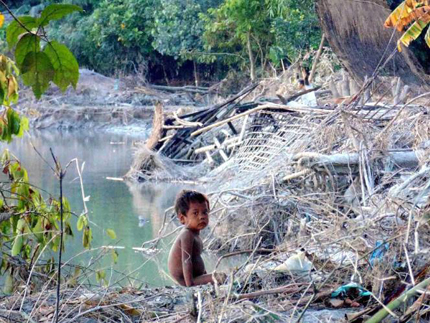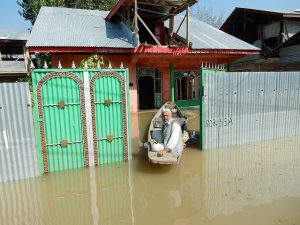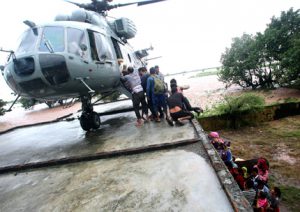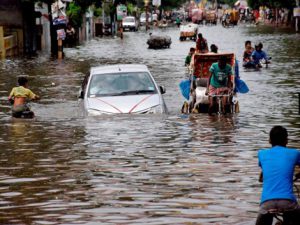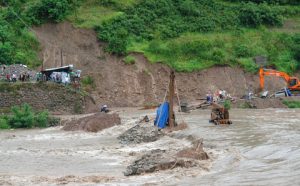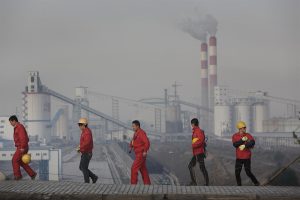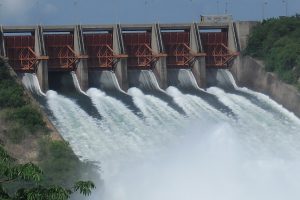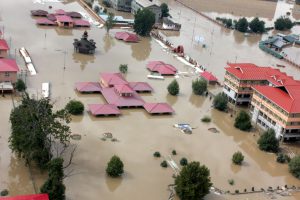“My village does not exist anymore. The river took it away.” The haunting words of Robin Das, a farmer whose home in Sengeli Suti village in India’s northeast Assam state was washed away, echo in the flood ravaged emptiness.
The 40-year-old and his family of five have been living on the roadside along with others from the village after waters from the Brahmaputra spilled over, leaving devastation in its wake. All they could rescue from the ravaging waters of the swollen river were a few pots and pans, some clothes and important documents.
Das is just one of the more than 1.6 million people affected by the floods in the state since August this year—a phenomenon that is as regular as the annual monsoon itself. But while they had survived the previous floods—either by raising everything in the house above knee level or by camping on the main road for a few days—this year has been disastrous for Das and the 30 families of his village.
Sengeli Suti, close to the Lakhimpur district, one of the worst affected by the floods this year, is a village on a river island in the Brahmaputra. Erosion by the floodwaters every year had started chipping away at the village island, and people recall how their land, agricultural and otherwise, was taken away by the river bit by bit before it was devoured completely.
“Every year a bit of our village land would get submerged in the water during the monsoon floods. A family who had shifted to our village after theirs was completely submerged said that this was how it began in their village island as well…and the nasty prediction came true,” Kobita Das, a resident of the village said.
Three million people living on the nearly 2,500 river islands on the Brahmaputra are vulnerable. In most places on the river islands, even the ‘chang ghars’, houses raised to an elevated level on poles to safeguard from the flood water, have failed to protect its inhabitants.
In Dhemaji, another badly affected district, Romen Chaliha talked about the huge loss they incur every year. “We are mostly agricultural famers, so you can understand how our lives turn when our crops get destroyed, animals get washed away and land gets submerged. After the water recedes, our paddy fields are left with sediments that make it infertile for agriculture for a long time.”
Chaliha has been living in the government set up relief camp with his family for the past two weeks.
The 620 km stretch of the Brahmaputra that flows through Assam is a source of livelihood for island dwellers as well as those living along its banks. They rely on the river to irrigate their crops and also for fishing, but come monsoon and everything changes. The life giver turns deadly as it swells and washes away life, land and property.
According to the latest data from the State Disaster Management Authority (SDMA), 35,654 people continue to remain affected by the floods in three districts—Dhemaji, Barpeta and Nagaon. A total of 195 villages are hit and 10,643 hectares of crops destroyed. Twenty people have also been killed by the floods as far.
Too little government action, too late
Unlike Jammu and Kashmir – where the worst floods in decades saw the summer capital Srinagar go under water – floods in Assam are not new. Such ‘misfortunes’ associated with floods can almost be anticipated. Yet, little has been done to protect the people and land.
The Assam government’s announcement this year, therefore, of forming a Flood and Erosion Protection Authority holds significance. The main aim of this body would be to strengthen the embankments and build new ones along the course of the Brahmaputra, as well as take up long term anti-erosion measures by dredging the tributaries of the river.
“It’s a good initiative, and can save a lot of lives as well as cropland and property that is destroyed every year. A strong embankment can withstand the pressure of the rising water and protect villages and towns. It will also prevent erosion which is slowly eating away chunks of land mass every year,” said Riturekha Baruah of the Centre for Northeast Studies and Policy Research (C-NES). Boat clinics, a C-NES initiative backed by the National Rural Health Mission (NRHM), Assam, and Unicef, has been doing relief work in flood affected areas of the state.
Not everyone is impressed with the government’s initiative.
Palash Mani Boruah, a college professor in Dibrugarh, a district affected by floods every year, says the government should do a re-think on the various engineering works that have changed the course of the Brahmaputra.
“The various hydropower dam projects in nearby Arunachal Pradesh and other such engineering works are affecting the course of the Brahmaputra and its tributaries are eroding the north bank, thereby making people living in the vicinity vulnerable. Since 1950, 4.27 lakh hectares of land in Assam has been lost to erosion, and 8,000 hectares is lost annually because of the same reason. One should think about that as well in order to prevent floods spelling disaster every year,” Boruah said.
Although the water level in the Brahmaputra and its tributaries is now flowing below the danger mark, the SDMA says that the Kaziranga National Park, famous for the one-horned rhino, continues to be affected with 30% still under water. As a result, animals have been coming on the main highway to escape the water, thereby becoming vulnerable to road accidents, and even poaching. The SDMA, however, mentions that an anti-poaching camp has been organised inside the park.
Relief camps are being set up—there are 33 functioning in the three districts now—and necessary supplies provided for immediate relief to the affected people. But, after the waters recede, another disaster awaits – water-borne diseases.
“When the water level goes down, that is when the risk of water borne diseases is the highest, and children are the most vulnerable. We have started distributing water purifying tablets, and medicines and making people aware of the dangers of diseases like diarrhoea, typhoid, that may befall on them if not careful,” Riturekha Baruah said.
The floodwater levels in Assam are now receding, the SDMA says, spelling good news for the affected people. But whether the government’s initiative will plug another flood of disaster next year remains to be seen.
